The nickname blue amaryllis does not quite fit the characteristics of the most unusual plant from the Amaryllis family - the exotic vorsley. Like a miniature palm tree, at the top of which lies a luxurious bouquet of watercolor blue bell flowers - this is exactly what this strange and rare plant looks like. The nature of the Worsley is not at all simple, but not so much as not to try to grow it. She differs little from her relatives. And if it is possible to organize the right lighting, there will be no difficulties. Finding the vorsley itself is much more difficult.
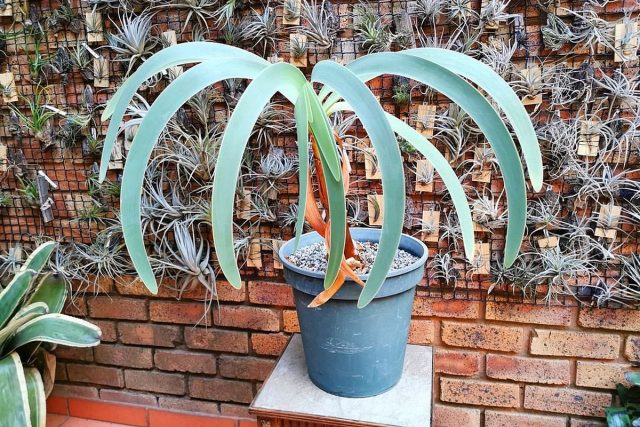
Plant description
Despite the monotypic nature of the Worsleya genus, it is no coincidence that it is considered one of the most striking in the Amaryllis family. The unusual structure and even more original flowering pleasantly distinguishes it from the hippeastrum and other species. For showiness, Worsley is also called the Empress of Brazil, although the nickname of the blue amaryllis is much more popular.
Worsleya noble ( Worsleya procera ) - maybe the only representative of the whole genus, but unforgettable. First, due to its size. This is perhaps the largest representative of the Amaryllis in all respects, in which the bulb, leaves, and even flowers seem simply gigantic. Worsley is a real giant among bulbous perennials.
The bulb of the Worsley is unusual, elongated-fusiform, with thick, fleshy, strong roots and a very long, stem-like neck up to 50 cm high. The gigantic sizes of wild piles - up to 1.5 m - do not reach indoor ones, but still, due to their size, spreading leaves seem giants for an ordinary window sill. In nature, vorsley grow in colonies, creating thickets like grasses. In the room, they release children less often, and even then they usually try to limit the “growth” by limiting the space in width, because the daughter bulbs develop to the detriment of the main plant, leading to a lack of flowering.
The false "stem" is crowned with a fan, a symmetrical rosette resembling a bunch of palm leaves. The leaves of the vorsley are also gigantic: with a width of up to 15 cm and a length of up to 90 cm, they bend in an ideal sickle-shaped arc and show off an unevenly expressed parallel venation. Rigid texture only emphasizes the flawless curve. The plant does not drop leaves for a relative dormant period.
Up to 15 flowers are collected in the inflorescence-brush above the leaves on a rigid peduncle. Huge funnel-shaped flowers up to 15 cm in diameter flaunt a long tube and wavy, pointed edges of the sepals. The structure of the flower is similar to lilies, the three lower and three upper petals are superimposed on each other, creating a perfect funnel. The stamens are large, beautifully curved. Purple or bluish-lilac at the ends and in buds, the flowers fade to an almost white throat, in which the smallest specks seem picturesque. Seeds at home are rarely tied. They are large, bizarrely semicircular, dark brown.
Worsleys traditionally bloom in early summer, but flowering directly depends on the quality of lighting and care, so it can either not start at all or shift. In an ideal greenhouse climate, vorsley can bloom almost all year round.
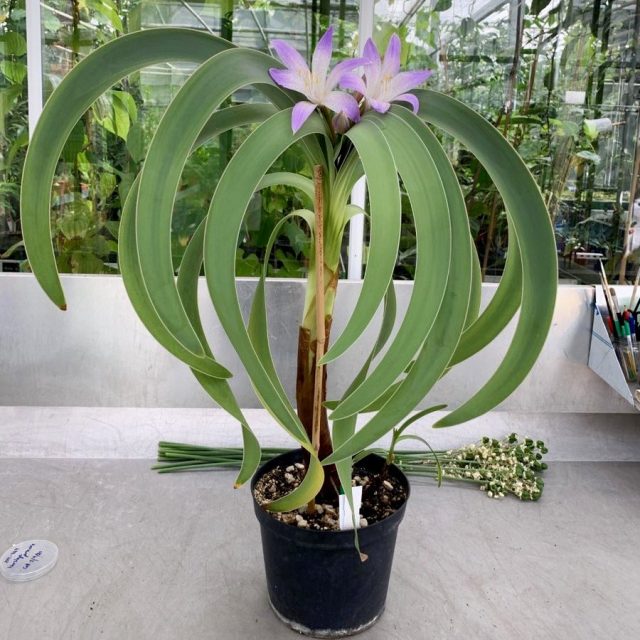
Growing conditions for indoor Worsley
Because of its natural range, vorsley is one of the most special houseplants. The thing is that in nature this beauty lives near waterfalls, in specific rocky soil. And these conditions of tropical Brazil have to be recreated in your interior. Therefore, it is not necessary to be surprised that this very expensive plant remains rare and exclusive. After all, ideal conditions for Worsley can only be created in winter gardens.
Lighting and temperature conditions
For vorsley it is necessary to provide the brightest possible lighting of the southern or western windows. She is not afraid of the direct sun, but she reacts very badly to the slightest lack of light. Since autumn, it is desirable to shift the vorsleys to the southern windows or illuminate them.
This plant loves differences in night and day temperatures, strong contrasts. Worsley copes much worse with the heat than with the cold. The optimal mode of keeping is with a daytime temperature of 22-23 degrees and a decrease at night by 5-6 degrees. The minimum allowable temperature is 2 degrees Celsius. It is not necessary to lower the temperature for the winter, but at 16-18 degrees the plant tolerates not the brightest lighting more easily.
Ventilation should be frequent, without fresh air the vorsley withers away. For the summer, it is desirable to take out the vorsley under the open sky.
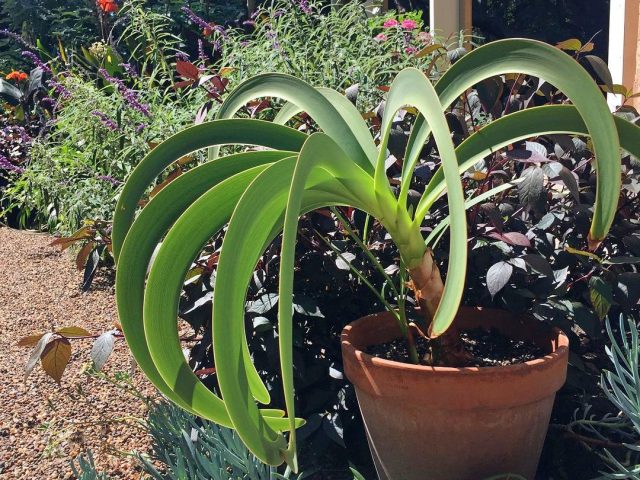
Worsley care at home
With deviations from the ideal care program, the Worsley suffers primarily from flowering. Therefore, it is better to monitor the humidity and try to protect the plant from any sudden changes.
Watering and air humidity
Finding the optimal watering strategy for vorsley is not easy due to the rough, specific soil. Worsley can be watered in the same way as orchids, allowing excess water to drain after a long soak. But so the risk of waterlogging, rot is much higher. Therefore, most growers prefer the time-consuming but reliable strategy of frequent daily watering, draining excess water from the trays immediately.
For a dormant period, stopping growth, watering is reduced by 2-3 times, but not stopped at all, preventing the roots from drying out.
Worsley is very sensitive to dry air. The minimum allowable indicators of 40% are needed for survival. But in order for the leaves to retain their decorative effect and the plant to bloom, it is better to maintain humidity at 55-60%. Worsley tolerates spraying well, but it is better to immediately consider installing a humidifier or a tray with wet moss.
Top dressing and fertilizer composition
Suitable soil for vorsley is not nutritious enough, the plant is largely dependent on fertilizer application. Feeding is stopped only during a period of relative rest.
Fertilizers with a high amount of potassium are preferred, but ordinary universal fertilizers, which are applied by dissolving in water for irrigation, will also work. The standard dose can be used once a week or evenly divided into micro doses for each watering.
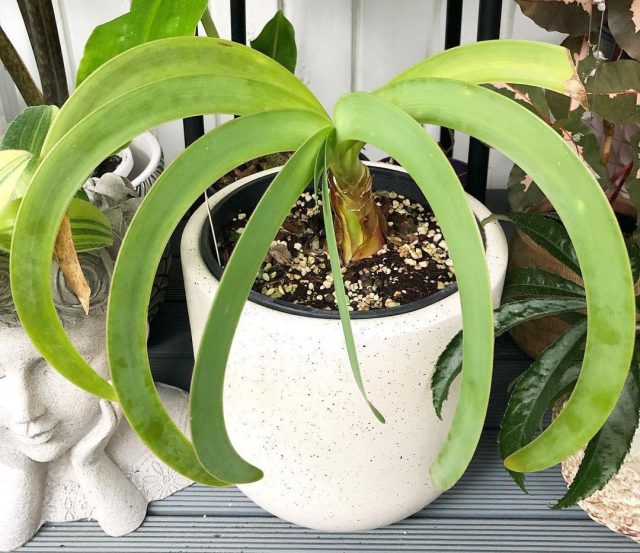
Pruning and transplanting vorsley
The leaves are removed after complete yellowing, carefully, to the base, with a sharp blade.
Worsley is moved to a new container when there is no room left for growth in the old one. Usually, transplantation is carried out very rarely, no more than 1 time in 3 years. Pots are selected so as to avoid excess substrate. In too wide pots, instead of flowering, the plant begins to actively release children, none of the piles in the pot can fully develop together. The diameter of the pot is selected so that about 4 cm remains to the walls from the edge of the bulb. Too much depth is easily compensated by high drainage.
The plant needs a rough, loose, non-moisture-intensive, rocky-sandy soil. Any drainage with a fraction of about 5 mm - lava, perlite, vermiculite, pumice - to which a little coniferous bark, coconut fiber, peat, sphagnum, coarse sand was added is considered an ideal soil mixture for vorsley. It is better to disinfect the soil in any convenient way.
When planting and transplanting, the roots and bulb must be carefully examined, cutting out all damaged tissues. Bulbs are treated in a weak solution of potassium permanganate or fungicide before planting. Large-fragment drainage should be laid at the bottom. Planting depth is the same as before, following the marks on the bulb. Usually, the bulb is immersed in the substrate only to the neck or the widest point, at least a third of the bulb should remain above the soil.
Diseases, pests and problems in cultivation
Worsley pests are rarely noticed, only in infected collections and scale insects, mealybugs and amaryllis bugs can “spread” on them. If you use non-professional soil without treatment, do not disinfect the bulbs, damage to both nematodes and onion mites is possible.
But much more often they lose vorsley due to rot and other fungal diseases that thrive in cold and dampness - stagonosporosis, anthracnose, fusarium, which have to be dealt with by emergency transplants and repeated treatments with fungicides.
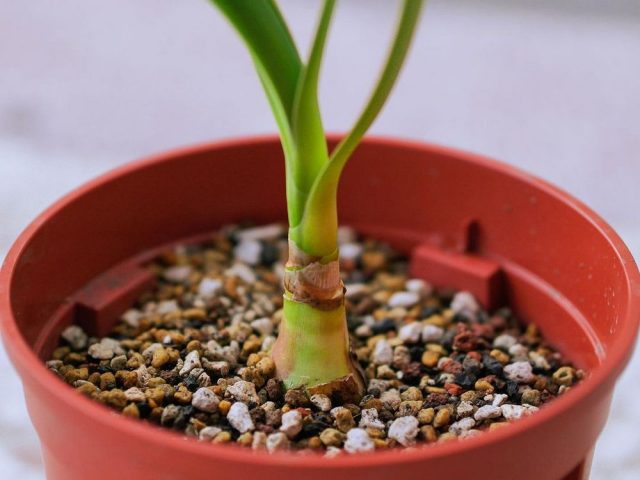
Worsley breeding
Preferably simple division, reproduction by daughter bulbs. Baby bulbs can be separated from the mother plant only when they reach a diameter of 2 cm, with the appearance of strong own roots.
It is possible to grow a vorsley from seeds, but it will take too long to wait for flowering, because fragile seedlings develop very slowly. Sow seeds in volcanic lava or pumice, perlite, vermiculite, a mixture of baking powder with peat and sand, superficially. The creation of "tropical" greenhouse conditions is a must.

.jpeg)


0 Comments
Post a Comment